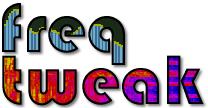|
FreqTweak supports manipulating the spectral filters at several frequency resolutions
(64,128,256,512,1024,2048, or 4096 bands) depending on your
needs/resources. Overlap and windowing are also selectable.
The GUI filter graph manipulators (and analysis plots)
have selectable frequency scale types: 1x and 2x linear, and two log
scales to help with modulating the musical frequencies.
Filters can be linked across multiple channels.
The plots are resizable and zoomable (y-axis) to allow precise
editing of filter values.
The current processing filters are described below in the
order audio is processed in the chain. Any or all of the
filters can be bypassed. The state of all filters
can be stored or loaded as presets.
- Spectral Analysis --
Multicolor scrolling-raster spectrogram, or energy
vs. freq line or bar plots... one shows
pre-processed, another shows post-processed.
- EQ Cut/Boost --
Your basic multi-band frequency attenuation. But
you get an unhealthy number of bands... Note that this EQ is not intended for
mastering purposes, it allows for (and doesn't protect against) highly irregular
filtering. Two versions, one does only frequency gain
cut, the other boost.
- Pitch Scaling --
This is an interesting application
of Sprengler's pitch scaling algorithm (used in
Steve Harris' LADSPA plugin).
If you keep all the bins at the same scale, it is
equivalent to Steve's plugin, but when you start
applying different scales per frequency bin, things
quickly get weird. For highest quality results (at the expense of transients) use
larger FFT (>= 1024 bins).
- Gate --
This is a double filter where
a given frequency band is allowed to pass through
(unaltered)
if the power on that band is between two dB
thresholds... otherwise its gain is clamped to 0.
- Delay --
This lets you delay the audio
on a per frequency-bin basis yielding some pretty wild
effects (or subtle, if you are careful). A feedback
filter controls the feedback of the delay per bin (be
careful with this one).
- Limit --
This is very harsh brick wall limiter on a per-bin
basis. It is not very pleasant, but can be interesting.
- Compressor --
This is a massively multiband compressor.
It will not behave quite like a normal
time-domain compressor because of the
inherent block processing of the FFT. Each
frequency bin has its own compressor
complete with Threshold, Ratio,
Attack/Release time, and makeup gain.
This is *not* suitable for mastering applications!
- Warp --
This one is a little different, both axes represent
frequency, and the identity matrix is unaltered
audio. Changing the value (height) of a bin,
reallocates the energy at that frequency to the new
frequency bin represented by the height of the bar.
For instance, if all bins are the same height, all
the frequency energy is added to a single bin. This
is a sensitive filter, the Log frequency scale is helpful here
(it affects both axes).
Modulators to an filter can be attached from the Modulations Window
(Control->Modulators... Ctrl-M). Add a modulator by clicking
on the Add Modulator... button and select from the choices. To
attach a modulator to a filter, click on the Attach... button on the
modulator panel and pick a filter. You can modulate many filters
simultaneously. The text entry fields can be used to exactly set
the slider values, by pressing enter/return after entering the number.
The following modulators are
currently implemented, with more to come soon.
- Rotate --
This will continually shift a filter horizontally at a constant
definable Rate, wrapping when it reaches the edge. The edges
are definable with the Min and Max Freq controls.
- Rotate LFO --
The same as the above, except the shifting rate oscillates via LFO
with its own Rate and Depth controls. Currently there are sine, triangle,
and square waveform shapes. The frequency range that the modulator affects
is definable with the Min and Max Freq controls.
- Value LFO --
Shifts the values up and down with an LFO. The depth control
here is percentage
of total value range. The frequency range that the modulator affects
is definable with the Min and Max Freq controls.
- Randomize --
Randomizes the bin values between the given value bounds
(as percentages of total range). Again, the frequency range
that the modulator affects is definable with the Min and Max Freq controls.
|
